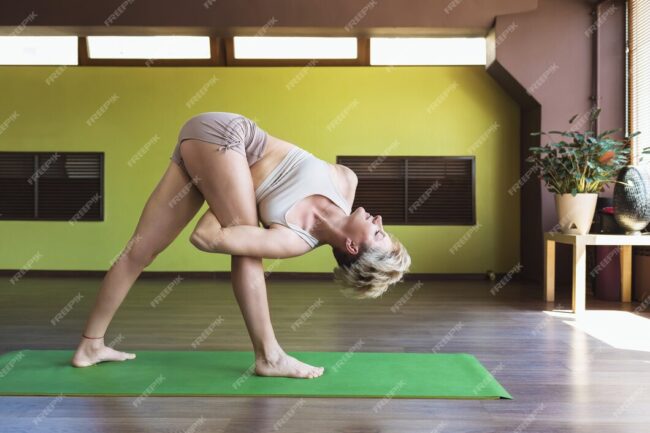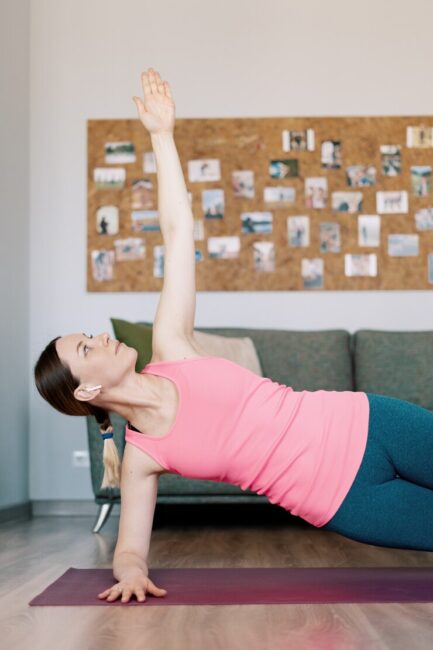
Stretching is an essential part of any fitness routine. It not only helps to improve flexibility and range of motion, but it also reduces the risk of injury during exercise. Before diving into your intense workout, take a few minutes to stretch out your muscles and prepare your body for the physical demands ahead. In this article, we will introduce you to 5 useful stretching exercises that will help you get the most out of your workout.
1. Standing hamstring stretch. This exercise targets the hamstrings, which are often tight from sitting for long periods or performing exercises that involve a lot of bending at the waist. To perform this stretch, stand up straight with your feet shoulder-width apart. Bend forward at the waist, reaching towards your toes. Hold for 20-30 seconds and then return to the starting position.
2. Quadriceps stretch. The quadriceps are the muscles on the front of your thighs and play a significant role in many leg exercises. Stand up straight and lift one foot off the ground, bending your knee. Grab your ankle and gently pull your foot towards your glutes until you feel a stretch in the front of your thigh. Hold for 20-30 seconds and then switch legs.
3. Shoulder stretch. This exercise targets the muscles in your shoulders and upper back. Stand up straight with your feet shoulder-width apart. Reach one arm across your chest, using your other arm to gently pull it closer to your body. You should feel a stretch in your shoulder and upper back. Hold for 20-30 seconds and then repeat on the other side.
4. Calf stretch. The calf muscles are often overlooked, but they can become tight and cause discomfort during exercise. Stand facing a wall and place your hands on it for support. Step one foot back, keeping it straight and pressing your heel into the ground. You should feel a stretch in your calf muscle. Hold for 20-30 seconds and then switch legs.
5. Chest stretch. Many exercises, such as push-ups and bench presses, put emphasis on the chest muscles. To perform this stretch, stand up straight with your feet shoulder-width apart. Clasp your hands behind your back and slowly lift your arms while keeping them straight. You should feel a stretch in your chest and shoulders. Hold for 20-30 seconds and then release.
Remember to breathe deeply and relax into each stretch. Do not push yourself too hard and listen to your body’s limits. By incorporating these stretching exercises into your pre-workout routine, you will help prevent injury and enhance your overall performance.
Stretching as an important part of a workout
Stretching plays a crucial role in any workout routine. It prepares your muscles and joints for physical activity, helps improve flexibility, and reduces the risk of injury. Incorporating stretching exercises into your warm-up routine can lead to better overall performance during your workout.
When you stretch, you are increasing blood flow to your muscles, which helps provide them with oxygen and nutrients. This can improve your muscle endurance and limit muscle fatigue. Additionally, stretching can help improve your range of motion, allowing you to perform exercises more effectively and with proper form.
Stretching also aids in injury prevention. By increasing the flexibility of your muscles and joints, you reduce the risk of sprains, strains, and other exercise-related injuries. Including a variety of stretching exercises that target different muscle groups can help to further decrease the likelihood of injury.
It’s important to note that stretching should be done properly and safely. Stretching should always be done after a warm-up, when your muscles are already warm. It’s important to hold each stretch for 10 to 30 seconds and avoid bouncing or jerking movements, which can lead to muscle strains. Remember to breathe deeply during each stretch to help relax your muscles.
In conclusion, stretching is an essential component of a workout routine. By incorporating stretching exercises into your warm-up, you can improve your flexibility, reduce the risk of injuries, and enhance your overall performance. Make sure to allocate enough time for stretching before every workout session to maximize its benefits.
The importance of stretching for the training process
When it comes to exercise, most people focus on the actual workout and forget about the importance of stretching. However, incorporating stretching into your training routine can have numerous benefits for your overall fitness and performance.
Stretching helps to improve flexibility, which is crucial for maintaining a full range of motion in your joints. It allows the muscles and tendons to lengthen and become more elastic, which can prevent injuries during exercise. By improving flexibility, you can also enhance your athletic performance and increase your power and speed.
Besides increasing flexibility, stretching also helps to improve blood circulation to the muscles. This increased blood flow delivers oxygen and nutrients to the muscles, which can help to reduce muscle soreness and promote faster recovery after a workout. Stretching can also help to alleviate muscle tension and tightness, which can lead to better posture and reduced risk of muscular imbalances.
Incorporating stretching into your training routine can also have psychological benefits. It can help to relieve stress and promote relaxation, making it an excellent way to unwind after a challenging workout. Stretching can also improve your mental focus and concentration, which can enhance your overall performance during training.
To ensure that you get the most out of your stretching routine, it’s essential to use proper form and technique. Avoid bouncing or jerking movements, as they can cause muscle strains or injuries. Instead, hold each stretch for 15-30 seconds and breathe deeply throughout the stretch. Remember to stretch both sides of your body equally to maintain balance and prevent muscle imbalances.
In conclusion, stretching is a crucial component of any training process. It can improve flexibility, increase blood circulation, relieve muscle tension, and provide psychological benefits. By incorporating stretching into your routine, you can optimize your overall fitness and enhance your performance during workouts.
The impact of stretching on workout results

Stretching is an important part of any workout routine, as it helps warm up the muscles and increase flexibility. However, the impact of stretching on workout results goes beyond just the physical benefits.
One of the main advantages of stretching before a workout is that it can help improve performance. When you stretch, you increase the blood flow to your muscles, which can enhance your overall strength and power. This can lead to better endurance and stamina during your workout, allowing you to push yourself harder and achieve greater results.
Stretching also plays a crucial role in injury prevention. By properly preparing your muscles before a workout, you can reduce the risk of strains, sprains, and other injuries. Additionally, stretching can help improve your posture and alignment, which can further protect your body during exercise.
Beyond the physical benefits, stretching can also have a positive impact on your mental state. Taking the time to stretch before a workout allows you to focus your mind and prepare mentally for the upcoming physical activity. This can help you enter a more focused and positive mindset, improving your overall workout experience.
It is important to note that there are different types of stretching, including static stretching, dynamic stretching, and proprioceptive neuromuscular facilitation (PNF) stretching. Each type has its own benefits and is suitable for different goals and fitness levels. It is recommended to consult with a professional or do some research to determine which type of stretching is most appropriate for your needs.
In conclusion, incorporating stretching into your workout routine can have a significant impact on your overall results. From improving performance and preventing injuries to enhancing your mental state, the benefits of stretching go beyond just the physical aspects. Make sure to make stretching a regular part of your workout routine to maximize your fitness journey.
5 useful stretching exercises

Before starting any workout, it is important to properly warm up your muscles and prepare them for exercise. One effective way to do this is through stretching exercises. Here are five useful stretching exercises you can incorporate into your pre-workout routine:
- Quad Stretch: Stand upright and grab your right ankle with your right hand, pulling it towards your glutes. Hold for 20-30 seconds and repeat on the other side.
- Hamstring Stretch: Sit on the floor with your legs extended in front of you. Lean forward, reaching for your toes while keeping your back straight. Hold the stretch for 20-30 seconds.
- Chest Opener: Stand tall with your feet shoulder-width apart. Interlace your fingers behind your back and lift your arms away from your body, squeezing your shoulder blades together. Hold for 20-30 seconds.
- Triceps Stretch: Extend one arm overhead and bend it at the elbow, reaching your hand towards the opposite shoulder blade. Use your other hand to gently push your elbow further into the stretch. Hold for 20-30 seconds and repeat on the other side.
- Child’s Pose: Begin on all fours, then sit back on your heels and slowly walk your hands forward, bringing your forehead to the mat. Relax and hold this position for 20-30 seconds.
Remember to never push yourself to the point of pain when stretching. These exercises should feel challenging yet comfortable. If you experience any discomfort, adjust the intensity or consult a professional for guidance.
Forward Bend
The forward bend is a classic stretching exercise that targets the hamstrings, lower back, and calves. To perform this exercise, stand with your feet hip-width apart and slowly hinge forward at the hips, keeping your back neutral and straight. Allow your hands to reach towards the ground and let your head hang freely. Hold this position for 10-30 seconds, breathing deeply and feeling the stretch in the back of your legs. If you feel any discomfort or pain, do not overstretch and modify the exercise to a comfortable range of motion.
Flexor Stretch
The flexor stretch is a great exercise to stretch your hip flexor muscles, which can become tight and shortened from prolonged sitting or inactivity. This exercise also helps improve your posture and flexibility.
To perform the flexor stretch, start by kneeling on one knee with the other foot flat on the ground in front of you. Make sure your back is straight and your core is engaged.
Slowly lean forward, shifting your weight onto the front foot while maintaining a straight back. You should feel a stretch in the front of your hip and thigh of the kneeling leg.
Hold the stretch for 20-30 seconds, breathing deeply and slowly. Avoid arching your back or leaning too far forward. Repeat the stretch on the other side.
Tips:
- Keep your upper body upright and your shoulders relaxed.
- Engage your glutes to maximize the stretch.
- If you have knee pain, you can place a folded towel or mat under the kneeling knee for support.
Remember to always warm up before stretching and listen to your body. If you feel any pain or discomfort, stop the exercise and consult a healthcare professional.
Quad Stretch
The quad stretch is a great exercise for stretching the muscles in the front of your thigh. It is especially beneficial for runners, cyclists, and those who perform activities that involve a lot of leg work.
To perform the quad stretch, follow these steps:
| Step 1: | Stand up straight with your feet hip-width apart. |
| Step 2: | Lift your right foot up towards your glutes, bending your knee. |
| Step 3: | Reach back with your right hand and grab your right foot or ankle. |
| Step 4: | Pull your right foot towards your glutes, feeling a stretch in the front of your thigh. |
| Step 5: | Hold the stretch for 30 seconds to 1 minute. |
| Step 6: | Release the stretch and switch sides. |
Remember to breathe deeply and relax your muscles while performing the quad stretch. Avoid pulling too hard and causing pain. If you have any existing injuries or medical conditions, it’s best to consult with a healthcare professional before attempting this exercise.
Incorporating quad stretches into your pre-workout routine can help improve flexibility, reduce the risk of injury, and enhance overall performance. It’s a simple yet effective exercise that targets an important muscle group in your legs.
Rotational Stretch
The rotational stretch targets the muscles in your torso, including your obliques, lower back, and hips. This stretch can be performed standing or seated, depending on your preference. Here is how to do it:
- Start by sitting or standing up straight with your feet shoulder-width apart.
- Place your hands on your hips with your fingers pointing towards your back.
- Slowly rotate your torso to the right, keeping your feet still. You should feel a gentle stretch in your lower back and obliques.
- Hold the stretch for 20-30 seconds, making sure to breathe deeply and relax into the stretch.
- Return to the starting position and then repeat the stretch, rotating your torso to the left this time.
Repeat the rotational stretch 2-3 times on each side, gradually increasing the range of motion as your muscles loosen up. This stretch can help improve your overall flexibility, increase range of motion in your spine, and alleviate tension in your lower back. It is a great pre-workout exercise to warm up your core muscles and prepare your body for physical activity.
Q&A:
Why is stretching important before a workout?
Stretching before a workout is important because it helps to warm up the muscles, improve flexibility, and reduce the risk of injury. It also helps to increase blood flow to the muscles, which can enhance performance during the workout.
What are some effective exercises for stretching before a workout?
There are many effective exercises for stretching before a workout. Some useful exercises include arm swings, leg swings, lunges, shoulder rolls, and neck stretches. These exercises help to loosen up the muscles and prepare them for the workout.
Is it necessary to stretch before every workout?
Stretching before every workout is not necessary, but it is highly recommended. While some studies suggest that stretching may not actually prevent injury or improve performance, many experts believe that it is still beneficial. It can help to increase flexibility, improve range of motion, and enhance overall athletic performance.
Reviews
Christopher
Stretching before a workout is an essential part of my exercise routine. It helps me improve my flexibility and prepare my muscles for the physical activity ahead. The five useful exercises mentioned in the article are great to incorporate into my warm-up routine. I particularly like the standing hamstring stretch as it effectively targets the back of my thighs. The quadriceps stretch is also a must-do for me, as it helps to loosen up my thigh muscles. The article provides clear instructions and helpful tips on how to perform each stretch correctly to avoid any injuries. I find that taking a few minutes to stretch before my workout not only prevents muscle soreness but also enhances my overall performance. Thanks to these exercises, I feel more prepared and focused when starting my workout session.
sophie85
Stretching before a workout is crucial for me as a woman to prevent injuries and improve flexibility. The article provides valuable insight into five useful exercises that I can incorporate into my routine. As a beginner, I appreciate the step-by-step instructions and clear descriptions of each exercise. The recommended exercises target different muscle groups, which is great for warming up my body before intense physical activity. I also like the inclusion of modifications for beginners, as it allows me to gradually work my way up to more advanced stretches. Overall, this article has given me the knowledge and confidence to properly stretch before my workouts, ensuring a safe and effective exercise session.
